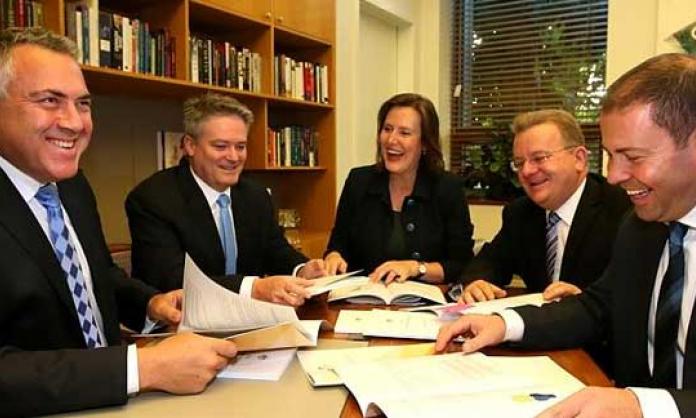Having tried to scare the daylights out of us last year with talk about unsustainable debt, the Abbott government is having another go with the latest Intergenerational Report (IGR) published by Treasury on 5 March.
We’re told that unless action is taken to reduce spending on social services and welfare, today’s Australians will be leaving the next two generations spiralling debt that will impoverish them for decades to come. They call this “intergenerational theft”.
The problem, the government argues, is that with an ageing population, the number of people reliant on state pensions and health services relative to the number of workers producing goods and services and paying income tax is growing all the time.
An ideological attack
The IGR, the fourth in a series first introduced by the Howard government in 2002, is an element in the neoliberal offensive against the working class.
The government is using the IGR today to justify snatching people’s entitlements to social security, or reducing the level of payment, forcing them to scratch around for work, any work, or face starvation.
It wants to reduce the age pension and make it harder to get. It also wants to force young people off Centrelink. It wants to push as many people off the disability support pension as it can get away with.
The logic isn’t just to reduce spending. The government wants to cut corporate taxes. So take from the poor and give to the rich.
It also wants to increase the size of the low wage workforce available to the corporations – the young, the sick and the old, those who have been pushed off social security and pension payments as a result of the cutbacks. Increasing the pool of desperate workers drags down wages for the entire working class.
The fraud behind the IGR
The IGR is not just a mean and tricky document that tries to pin the country’s problems on alleged mismanagement by the Rudd and Gillard governments. It provides cover for an attack on the most vulnerable in our society in the name of economic sustainability. It is an obnoxious document that considers people only to the extent that they contribute to or draw from the tax coffers and not as fully-fledged citizens and human beings. It reinforces the notion that the purpose of the economic system and of government is simply to prop up the status quo.
The government is using lots of scary figures about debt to do this. But a lot of these are based on a string of questionable assumptions. Given that Treasury is constantly revising its GDP estimates even one year ahead, we cannot have much confidence in its debt projections for 2055. Simply changing the projection for the number of immigrants arriving in Australia every year over such a long period will have a big impact on the likely fiscal situation.
What we do know is that the Australian government currently has one of the lowest debts in the OECD, interest payments on which account for only half a percent of GDP. We know that the debt problem, such as it exists, is due to a series of tax cuts for higher income earners introduced since the latter years of the Howard government.
Government spending is not the problem: adjusted for inflation, government consumption expenditure per head of population has actually fallen from $14,300 to $11,700 since 2004.
The real theft
The real thieves in our society – those who take without ever giving – are the rich and big business, not age pensioners or the sick. They create no value but live off the labour others. Every member of the working class, by contrast, creates value or contributes to the creation of value elsewhere, from the moment they start work to the moment they quit.
There’s one scary graph you can be sure won’t be paraded around by Hockey as he promotes the IGR as part of his “conversation with the Australian people” in the run-up to the May budget. That’s the graph showing the redistribution of wealth from the working class to the capitalist class in the past four decades.
When the Fraser Liberal government was elected in 1975, the profits share of national income represented 17 percent of GDP; today it is 27 percent. The wages share has fallen from 61 percent to 54 percent. Workers are producing more than ever before, but more of what they produce is now going to their employers. That extra 10 percent of GDP translates into business enjoying a $150 billion windfall every year. Now that’s dependency. Our problem is not intergenerational but interclass theft.
We don’t have to accept the undermining of welfare, no matter how much Treasury and the government try to convince us that we do. If we taxed business and the rich seriously, we could eliminate government debt overnight. But that means taking on the real dependents on our society – not the elderly getting by on less than $400 a week but those who earn this every minute of the day without ever breaking into a sweat.
Let’s be clear. The real intergenerational threat faced by our children and grandchildren is not the miserable allowances received by today’s age pensioners or sole parents, but joblessness – youth unemployment is now at its highest since the 1990s.
Other genuine threats include the prospect of $100,000 degrees and the burden of debt repayment stretching out for years, the lack of access to home ownership for younger Australians because of tax breaks to landlords which push up prices for first home buyers, and the very real dangers presented by global warming caused by governments who declare that “coal is good for humanity”.
Dealing with these actual threats means challenging our government, not going along with this latest round of scaremongering by Abbott and Hockey.









